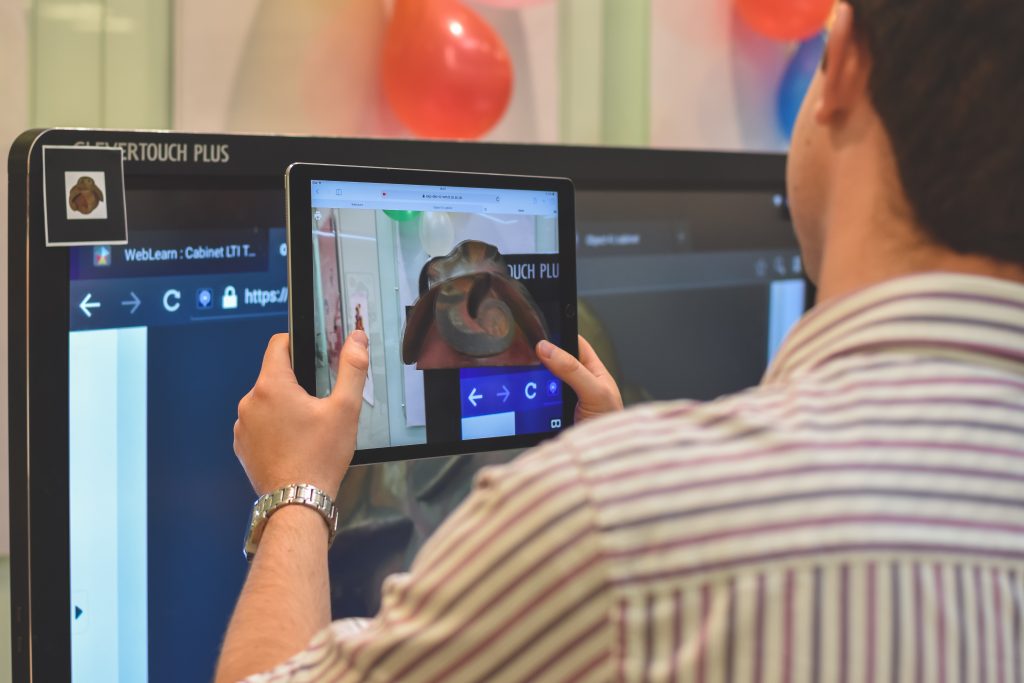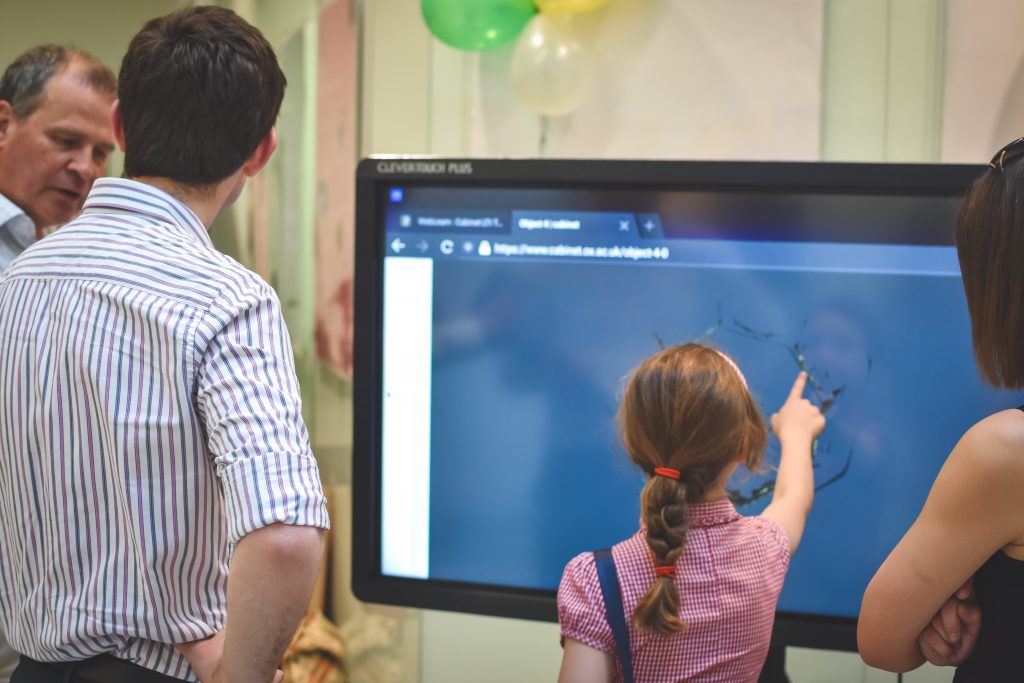In this interview, Kathryn Eccles talks about Open Cabinet, which is one of the 2018 IT Innovation staff projects. She outlines how this project will bring benefit to members of the University and shares some great tips for applying to the IT Innovation Challenges funding scheme.
Open Cabinet will use augmented reality (AR) technology to create new opportunities for virtual handling of 3D artefacts in museums. The project has two main aims. Firstly, it will embed objects more deeply into the learning experience at Oxford by creating animated AR experiences within museum displays, amplifying the objects’ power and meaning through the rich contexts the galleries provide. Secondly, it aims to enhance the public visitor experience by using this innovative technology to improve access to objects without altering the highly-valued appearance and atmosphere of the museums. The Pitt Rivers Museum holds significant material (text, images, audio, video) relating to its artefacts, and AR provides a mechanism for both ‘extending’ displays by employing these rich materials, and adapting them for visitors with diverse needs, all without the intrusion of permanent, fixed screens in galleries. As the content is activated by a device held up to the display, the Open Cabinet project can encourage deeper engagement whilst avoiding ‘heads down’ distraction.
1. Please tell us a little bit about the team behind Open Cabinet.
The Open Cabinet project has given us an opportunity to formally bring together colleagues who have been working together informally for quite some time. I (Kathryn Eccles) have been leading the Cabinet project (an early IT Innovation project) at the Oxford Internet Institute since 2015, as I’m interested in how digital technologies can open up access to cultural heritage resources for teaching and learning. Jamie Cameron (OII) joined the team soon after, bringing expertise in modelling objects in 3D that he’d acquired during his Archaeology degrees. The award-winning Cabinet platform was developed by Ted Koterwas and his team at IT Services, and it was at one of our regular meetings with Ted that we discussed the idea of using augmented reality to open Cabinet up to new audiences and learning experiences. The Technology Enhanced Learning team has been supporting Cabinet for a number of years, so we were delighted to bring Xavier Laurent into the Open Cabinet team to advise us. Finally, we had been looking for an opportunity to work with Chris Morton and his colleagues at the Pitt Rivers Museum, as they’d been so supportive of the Cabinet project from its inception, and the PRM was clearly an ideal space in which to try out the AR technology that allows us to enhance, but not disturb, the displays. We had also been thinking in more depth about how AR could be used to provide content to visitors with additional needs, and having previously worked with Susan Griffiths to create 3D printed models for use with blind and partially sighted visitors, we felt that her experience would be invaluable to create a widely useful tool.
2. How did you come up with the idea for Open Cabinet?
We’d been mulling over the potential for AR for some time, as we’d often been asked about augmented and virtual reality since launching Cabinet. 3D models of objects lend themselves particularly well to those environments. For us, AR was the obvious choice as it has the ‘wow’ factor, and therefore promotes social learning and engagement. We’d also seen a few AR projects that we really admired, such as the Smithsonian’s Skin and Bones project, and had increasingly wondered whether we could do something similarly dynamic to bring exhibits in Oxford to life. Augmented reality can allow objects and ideas out of the cases without having to disturb the displays, which made it ideal for the Smithsonian’s famous Bone Hall, and similarly perfect for the Pitt Rivers Museum, which is highly prized for its atmosphere and architecture. The final piece in the puzzle was when we heard from students who’d been studying with Cabinet that they often ‘treated’ themselves to revision trips to the museums, but felt that they would benefit from some guidance once they were there. We instantly saw that we could develop something that would benefit both students and casual museum visitors, keeping the rich content that is at the heart of Cabinet, but making it a more playful experience tied to the galleries themselves.
3. Why did you choose to apply for the IT Innovation Challenges scheme?
The IT Innovation Challenges scheme allows you to take a ‘wouldn’t it be brilliant if…’ idea and actually have a go at it. It’s the ideal scheme for a project like this, which is risky (all innovation is risky!), practice-led and interdisciplinary/cross-divisional. We’d also had a previous success story with the original Cabinet project, which went from IT Innovation project to a University-supported service within three years, thanks in large part from the brilliant support we got from IT Services and GLAM.
4. What was the application process like for you? Which tips would you give future applicants?
It was pretty straightforward for us, because we’d been through it once before. The first time around, the jump from short abstract to longer project proposal was a bit intimidating. However, the full application forces you to get your ducks in a row, which in turn makes it easier to get the project underway if you’re lucky enough to win the funding. My top tips would be:
- (1) to plan as though you will get through to the second round, so that you have booked time with everyone involved to get that proposal written, and
- (2) make the most of the opportunity to post your idea early, as you’ll get such helpful feedback and input.
5. What are your plans for the next few months? How will you realise your project idea?
Our first phase will focus on selecting and modelling objects from the Pitt Rivers, and holding a number of user experience focus groups so that we get the best possible design of the Cabinet AR tool. We had already experimented with a prototype and some sample objects from Cabinet over the summer, so we had done quite a bit of thinking about what we wanted the tool to look like. We now need to work with users to make sure that what we’re proposing is easy and fun to use.
6. How will the Open Cabinet project bring benefit to students, staff and the University?
We hope that Open Cabinet will engage students, staff, the wider University and visitors to our award-winning museums with an exciting new way of discovering and learning about objects. The AR technology is deliberately playful, making it an ideal vehicle for breaking down barriers around learning with objects and demystifying museum displays by offering a range of multimedia resources to bring them to life. We know that students enjoy visiting the museums, and we hope that Open Cabinet can make those experiences even more engaging and beneficial to learning.
